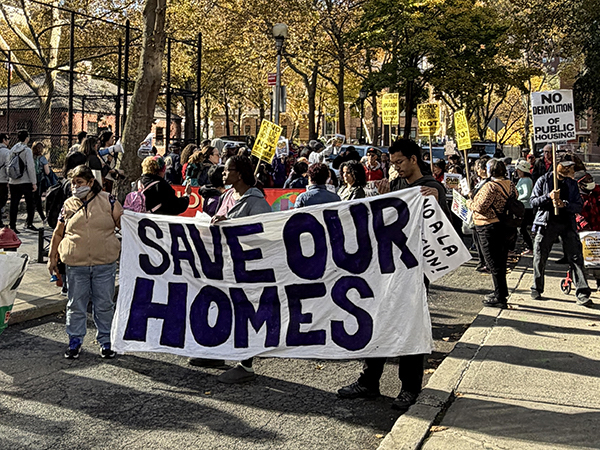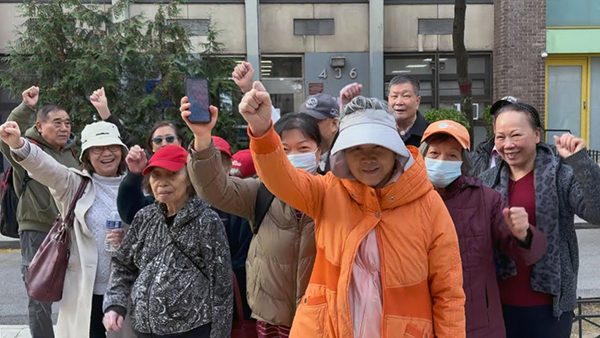The following Guest Opinion piece by David Holowka is a reprint of content that first appeared on November 14, 2025 on Holowka’s blog, ArchiTakes. To access that version, click here. All photos and images are by or courtesy of David Holowka, unless otherwise noted.
 Residents of Chelsea’s Fulton and Elliott-Chelsea Houses (FEC) protested NYCHA’s planned demolition of their buildings with a march and rally on November 8th. The lack of tenant buy-in for the plan is increasingly an issue. The high-profile architecture firm PAU (Practice for Architecture and Urbanism) recently withdrew from the project to demolish and replace the buildings alongside new housing, citing concerns about resident engagement. In an October 30th lecture at the Spitzer School of Architecture, PAU Principal Ruchika Modi presented a slide of her firm’s mission statement: “PAU is an architecture and urban design studio dedicated to building ecological, equitable, and joyous communities.” Challenged by an audience member on the firm’s seemingly contradictory involvement in the NYCHA plan, Modi announced that PAU had bowed out of it after gathering that no proper resident engagement was carried out.
Residents of Chelsea’s Fulton and Elliott-Chelsea Houses (FEC) protested NYCHA’s planned demolition of their buildings with a march and rally on November 8th. The lack of tenant buy-in for the plan is increasingly an issue. The high-profile architecture firm PAU (Practice for Architecture and Urbanism) recently withdrew from the project to demolish and replace the buildings alongside new housing, citing concerns about resident engagement. In an October 30th lecture at the Spitzer School of Architecture, PAU Principal Ruchika Modi presented a slide of her firm’s mission statement: “PAU is an architecture and urban design studio dedicated to building ecological, equitable, and joyous communities.” Challenged by an audience member on the firm’s seemingly contradictory involvement in the NYCHA plan, Modi announced that PAU had bowed out of it after gathering that no proper resident engagement was carried out.
NYCHA’s plan would demolish FEC’s 18 apartment buildings and reconstruct their 2,056 apartments, minus 260 bedrooms, in three very large buildings on each development’s campus. These would be sited on about a third of the current campus grounds to make way for 3,500 new mixed-income units in buildings up to a contextually incongruous 39-stories tall. About 1,000 of the new units would be affordable—mainly to middle-income New Yorkers—and the rest market rate. In this part of Chelsea, market rate means luxury.
News of PAU’s withdrawal comes as resident engagement has entered its ugliest phase yet, with seniors traumatized by threats of eviction and worse if they don’t surrender their homes and agree to transition from Section 9 status, as tenants of the government, to less secure Section 8 status, as tenants of the Related Companies. (Related is NYCHA’s private development partner for the plan under its PACT program and the giant developer of Hudson Yards.)
Holdout residents of the first two buildings slated for demolition have recently been slammed with individual New York County Supreme Court summonses threatening money damages. In taking a Supreme Court route, with 7:00 a.m. delivery of summonses no less, NYCHA clearly means to intimidate the residents and place them at a legal disadvantage. Housing matters are usually adjudicated in Housing Court, where tenant-protective procedures would kick in. This should particularly concern Chelsea’s Assembly Member, Tony Simone. His op-ed, “No Tenant Should Face Eviction Without Representation,” calls for passage of a statewide Right to Counsel law that would provide free legal services to tenants who can’t afford a lawyer. Simone has supported the NYCHA plan in the face of stiff community opposition.
PAU’s defection is no small news. It casts doubt on the claim underlying both NYCHA’s plan and its support by Chelsea’s elected officials that demolition and replacement of the FEC buildings is the established will of the residents. The electeds and NYCHA continue to cite a misleading 2023 resident survey on renovation versus building replacement that was only called a vote after it was given, never used the word “demolition,” and failed to indicate that renovation might take as little as two years versus six for replacement. The survey saw only 29% participation—with rebuilding favored by just 4% of the total FEC population—and was based on false claims and misinformation that have since been exposed.
Despite this, both City Council Member Erik Bottcher and Assembly Member Simone defended the plan in a raucous town hall in July, going out on a limb to say they would never support a plan that wasn’t supported by the majority of the residents.
When asked where he stood on NYCHA’s plan in a June “Conversation with Zohran Mamdani about Public Housing in NYC,” the now-mayor-elect said he would support the will of the residents—but didn’t pretend to know it as Bottcher and Simone do. Hopefully he’ll have the integrity not to believe whatever suits him.
There should be no doubt where the residents stand. In two years of Community Board 4 meetings and NYCHA public hearings, the overwhelming majority of testimony by residents has been against demolition. When Fulton Houses resident Jackie Lara ran in last year’s City Council primary on a no-demolition platform, she won the election districts containing both the Fulton and Elliott-Chelsea Houses and as a political novice took a whopping quarter of the total vote from incumbent Bottcher. In January, Renee Keitt ran as a no-demolition candidate for presidency of the Eliott-Chelsea Houses Tenants Association and defeated a longtime pro-demolition incumbent. When about fifty people testified at each of NYCHA’s two in-person public hearings last April, one at Fulton and one at Elliott-Chelsea, all but two spoke against demolition. Over a thousand residents to date have signed a petition against demolition, more than the total number who participated in the 2023 survey. In August, FEC residents packed a special meeting of CB4’s Chelsea Land Use Committee on the plan. When supporters of demolition were asked to raise their hands, a few went up. When opponents were asked, the room was a forest of raised arms.
Chelsea’s elected officials should of course also consider the will of FEC’s surrounding community, which stands to suffer a staggering loss of neighborhood character along with the environmental impact of a vast demolition and construction project estimated to last 16 years. The plan has been opposed in virtually unanimous testimony by the wider community and is not supported by Community Board 4. Erik Bottcher apparently felt compelled to meddle with the board on behalf of the plan earlier this year when he told Viren Brahmbhatt, a member of the board’s Chelsea Land Use Committee, that he had not reappointed him. An architect and urban designer with critical qualifications for the committee, Brahmbhatt had recently urged its members to take a strong position against the plan. Bottcher reversed himself and reinstated Brahmbhatt when his removal was publicized and became a public-relations liability.
Many see the resident survey as calculated to cut FEC’s surrounding community out of participation. The elected officials were quoted by CB4 leaders after a summit between them last January as saying the survey had been their idea. They were also said to have expressed “resentment” toward “wealthy outsiders”—their own rightfully concerned constituents—who had organized opposition to the plan. If the survey was conceived to play the FEC residents against their neighbors, things haven’t worked out that way. The residents and other members of the community have joined forces to fight the plan.
It’s growing unpopularity among FEC residents is a natural reaction to NYCHA’s and Related’s repeated bait-and-switch manipulation. Even Related’s minority-owned partner for the project, Essence Development, isn’t what it at first seemed. Its managing principal Jamar Adams left his job as a Related vice president to found Essence shortly before the team pursued the FEC project. Essence turns out to be effectively a Related spinoff.

Many tenants of the senior building on the Elliott-Chelsea campus, including these Chinese residents, vehemently oppose demolition. Their 96-unit building, known as Chelsea Addition, stands at 436 West 27th Drive. NYCHA plans to relocate the building’s residents into “refreshed” vacant apartments scattered among a number of buildings throughout the campus for the three years it’s estimated to take for Chelsea Addition’s demolition and construction of a replacement building. Given the residents’ advanced age, these may be their last homes. One temporarily relocated senior has already died, certainly the first of many to come.
Chelsea Addition residents say they look after each other like family and are sleepless with dread of relocation. They don’t want to be separated, and fear losing the safety from crime that goes with living in an all-senior building—certainly much of the reason it was built as one in the first place.
These vulnerable residents’ safety concerns won’t end when they eventually move into their permanent replacement building. It will be much larger and taller—39 stories—and house residents of all ages. Bigger and taller public-housing buildings are inherently harder to monitor and secure. This will be an issue for all of the FEC residents as they move from 18 buildings into just six far larger ones. NYCHA literature describes planned “lobby attendants” but not 24-hour doormen.
When NYCHA surveyed the FEC residents in 2023, Chelsea Addition’s seniors were told that if building replacement went forward they would be temporarily moved together into 311 Eleventh Avenue, a nearby, newly completed Related development. Branded as 3ELEVEN, it’s a luxury-doorman rental building billed as having “over 60,000 square feet of amenity spaces” including a rooftop pool, sky lounge, fitness center, dog runs, and a game room. The building also has a supermarket on its ground floor.

3ELEVEN, at left above, is a southward extension of Related’s luxury-housing line-up at Hudson Yards, seen at right across Eleventh Avenue. The penthouse of the middle tower on the right played home to Jeremy Strong’s character Kendall Roy, the super-rich scion of the Murdoch-inspired Roy family in HBO’s “Succession.” Many see the NYCHA plan as a land grab by Related to drive a zone of luxury housing from Hudson Yards down through Chelsea parallel to the High Line’s residential gold coast—a planned program of mutually-price-enhancing properties that could bring a firestorm of hypergentrification.
Chelsea Addition residents were wowed when they visited 3ELEVEN’s lobby. The prospect of living there may have swayed them to select the new-construction option on the 2023 survey or, more recently, agree to vacate the senior building. After dangling this glittering future before the seniors, NYCHA has now cruelly snatched it away. Like other claims employed to advanced the plan, it was retracted once it had served its purpose. It’s hard to imagine Related would ever have let public-housing residents into one of its luxury buildings; the entire FEC project is predicated on segregating them from the wealthy newcomers who will take over the lion’s share of their current grounds.
NYCHA’s claim that it would relocate the seniors to 3ELEVEN is confirmed in a 2023 piece from the time of the survey by Brian J. Pape in The Village View: “Depending on the outcome of the tenant vote, [sic] PACT (Related and Essence) is proposing in Option One to build new NYCHA apartments while tenants live in the old ones, except the 436 West 27th Drive tenants will be relocated to 311 Eleventh Avenue for the interim.”
Pape’s article reported NYCHA’s claim that “updating of the existing buildings would indeed take longer and be more costly” than rebuilding them. The agency now says rebuilding will cost upwards of a billion more and take three times as long—another reversal made after conclusion of the survey, which would never have been given but for Related and NYCHA’s lie that renovation and replacement were a toss-up that the residents should be allowed to decide. Pape also tellingly described a tenant-outreach meeting for Elliott-Chelsea residents “attended by just four other residents and Darlene Waters, the Tenant Association President.” Waters was the longtime incumbent booted by residents more in agreement with Renee Keitt’s “no-demolition” campaign message.
The effectiveness of NYCHA’s outreach to FEC residents is in serious doubt. Chelsea Addition residents point to failed translation services for Poles, Russians, and Chinese. They say many tenants understand little about what’s going on and don’t even realize they would transition from Section 9 to Section 8.

Anyone looking at NYCHA buildings might wonder what’s to love or why their tenants would want to keep them, but their appeal is in the spaces between. The façades of the Fulton Houses towers pictured above are separated by nearly 200 feet, providing enviable light, air, long views, and privacy. The staggered layout of the campus’s buildings is all about creating this kind of spatial generosity, a deliberately planned escape from cramped tenement conditions for low-income New Yorkers. The Elliott-Chelsea campus provides similar spatial release.
It’s unclear how well FEC residents anticipated the loss of this space. Those who took the survey couldn’t know that NYCHA would later claim the right to locate new buildings without regard for current zoning’s minimum distance-between-building requirements.
NYCHA at first promised to apply all revenue from new mixed-income housing development on the campuses to better homes for the FEC residents. That suggested no more private development would be built than needed to provide them with decent housing. In theory, any loss of space or grounds would pay for a better net quality of life. In a CB4 meeting last December, NYCHA announced that it might instead channel all of that revenue into its general fund for use throughout the city, and that the FEC replacement buildings might be funded entirely through Low-income Housing Tax Credits and other financial incentives for new construction—limited funding sources that could be better spent than on needless replacement of sound buildings. This appears to have been the agency’s plan from the start and explains the excessive amount of proposed new development.
The FEC residents would pay in light and air not to improve their own conditions, but those of public-housing residents throughout New York. That’s not what the 2023 survey respondents who stated a preference for new construction bargained their open space away for. Erik Bottcher has said he opposes NYCHA’s extraction of revenue from Chelsea, but instead of calling for scaled-back new development, he proposes making more of it affordable housing. That’s no more what the survey respondents had in mind than bailing out NYCHA. The survey was less to give the residents what they want than to serve the agendas of NYCHA, Related, and elected officials intent on building a track record of housing creation—at any price and no matter how unlikely the new units in question are to lower New York’s housing costs.
Biophilia—the innate human desire to reconnect with the nature in which we evolved—has recently become an architectural buzzword, but it has informed the design of towers-in-the-park developments like NYCHA’s for nearly a century. Its campuses also anticipate today’s concern for environmental justice, which aims to spare marginalized communities the environmental harms they have disproportionately suffered in the past and provide them equal access to environmental benefits. This creates a dilemma for supposedly enlightened politicians who support NYCHA’s Chelsea plan; it would compact and segregate the FEC residents onto a small fraction of their current grounds and cut down all their trees so the balance of the campuses can be handed over primarily for homes for the wealthy, and to enrich Related.
On this subject, Erik Bottcher’s August 12th online “Policy Perspective” about the New York City Urban Forest Master Plan was a masterclass in hypocrisy. Its promotional text read:
Trees are one of the most cost-effective tools we have to fight climate change. They pull carbon dioxide out of the atmosphere, reduce the need for energy-hungry air conditioning, and make our neighborhoods more resilient to extreme heat and flooding.
They’re also a matter of environmental justice. The hottest, most polluted neighborhoods in our city are often the ones with the fewest trees—and these areas are disproportionately home to low-income New Yorkers and communities of color. Planting more trees in these areas isn’t just good policy—it’s a step toward correcting long-standing inequities in how public health and environmental resources are distributed.
Well, what about cutting down 370 mature trees on the FEC campuses, home to thousands of low-income New Yorkers? Even with those trees, their neighborhood has among the city’s worst air pollution. It is in the city’s zone of least tree cover, least temperature reduction by trees, least pollution removal by trees, and least runoff avoided by trees, according to a 2018 federal government study. Bottcher seems to be calling for a return to the old inequities NYCHA sought to redress when it first built its developments.
Several who attended Bottcher’s event submitted questions about the coming NYCHA treepocalypse, which he refused to answer. Most of a century old, the FEC trees have grown far larger in their park-like settings than any tree in a sidewalk pit ever could. These large trees capture exponentially more carbon than the street trees that concern Bottcher. NYCHA was asked for an analysis of the impact of their loss by CB4 in its comments on the project’s Draft Environmental Impact Statement. The agency responded that this assessment was “outside the scope” of the Environmental Impact Statement. Who knew trees weren’t part of the environment? NYCHA gave a similar response to a CB4 request for an assessment of the vast embodied carbon associated with the plan’s needless demolition and replacement of the FEC buildings.
Critics of the train wreck that is NYCHA were encouraged by mayor-elect Mamdani’s mention of the agency in his acceptance speech: “We will work tirelessly to make lights shine again in the hallways of NYCHA developments where they have long flickered.” As the agency’s troubling blueprint for the future of New York public housing, the FEC plan cries out for his attention.
The new mayor should use his platform to push for resourceful funding streams for public housing like repeal the Reagan-era stock transfer tax rebate, as proposed by a bill now before the State Senate and Assembly. Five percent of the revenue this would release, an amount approaching a billion dollars per year, is earmarked for NYCHA. What’s a socialist to do? Keep bailing out Wall Street, or provide decent homes for low-income New Yorkers?
Revenue from repeal of the rebate could fund Renee Keitt’s ideal public-housing solution: a NYCHA program called Comprehensive Modernization, or Comp Mod. Tested in a handful of demonstration cases, it offers more thorough renovation than NYCHA’s other programs including upgrades to energy performance, and it crucially allows residents to keep Section 9 status. New Yorkers who voted for Mamdani dreamed of a new day. Maybe that could be part of it.
—END—
NOTE: The views expressed by our Guest Opinion writers are not necessarily those of Chelsea Community News.
ChelseaCommunityNews.com (CCNews) is an independent, single-owner online newspaper providing news, arts, events, and opinion content to Manhattan’s Chelsea community and its adjacent areas (Flatiron/NoMad and Meatpacking Districts, Hudson Yards, Hell’s Kitchen, Broadway/Times Square, and the Penn Station area). Our editorial content is made possible by advertising revenue, grants, quarterly pledges of support, and voluntary reader donations (click here for our GoFundMe campaign). To join our subscriber list, click here to receive ENewsletters containing links to recently published content–as well as an occasional “Sponsored Content” email featuring an advertiser’s exclusive message.
ChelseaCommunityNews.com is a member of the New York Press Association (NYPA) and the Empire State Local News Coalition. Our content is collected for placement in the United States Library of Congress’ LGBTQ+ Studies Web Archive. (“We consider your website to be an important part of the historical record,” read a July 26, 2019 email.) Our freelance reporters have been recognized by NYPA’s annual Better Newspaper Contest, with Honorable Mention wins for Best News or Feature Series (2021 & 2023). CCNews is a three-time winner in the Coverage of the Arts category (First Place and Honorable Mention, 2022 and Third Place, 2023).
PLEASE SUPPORT LOCAL JOURNALISM: HELP CHELSEA COMMUNITY NEWS THRIVE BY FREQUENTLY VISITING THIS WEBSITE TO READ OUR ARTICLES AND CLICK ON THE ADVERTISEMENTS.
Questions? Comments? Want to Place an Advertisement or Make a Donation? Email Founder/Editor Scott Stiffler at scott@chelseacommunitynews.com.

You must be logged in to post a comment Login